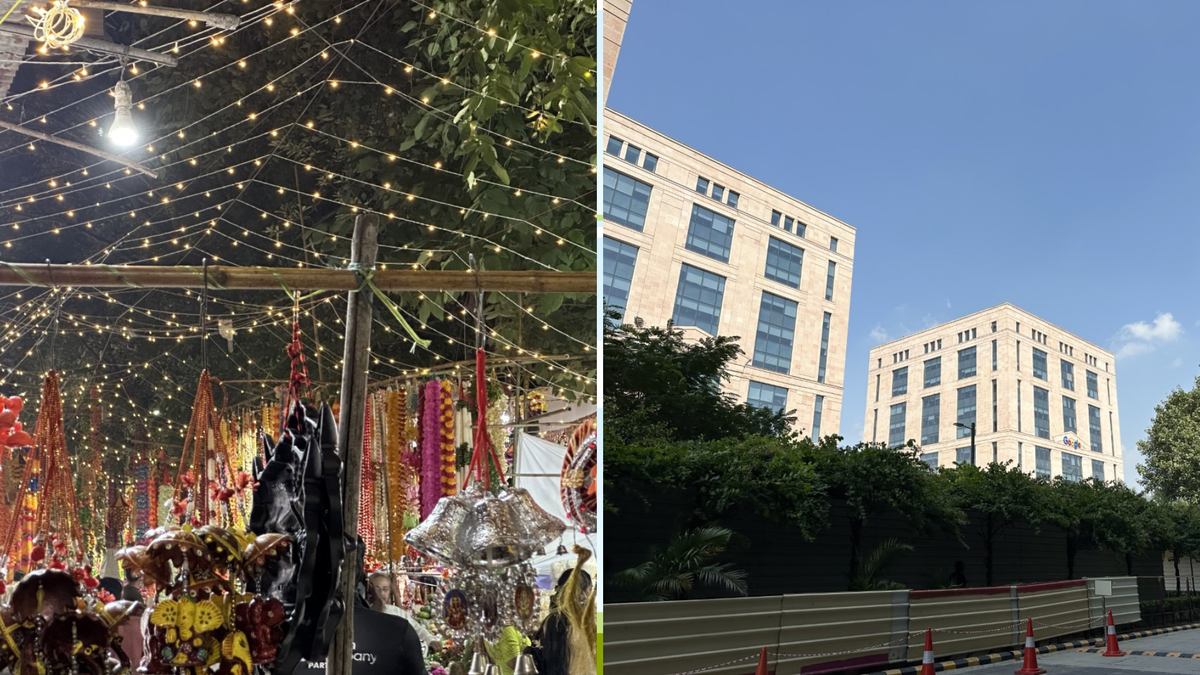The iPhone 14 Pro, with its dynamic island, improved camera setup, and AOD, is a worthy upgrade but the bold choices from Apple need work
Apple has now started broadly classifying its base variants versus the Pro models starting with the iPhone series 14. The U.S. headquartered company launched the 14th gen of iPhones last month keeping the base variant almost the same as its predecessor but on the contrary, the Pro versions came with some fundamental changes. Today, we talk about the Apple iPhone 14 Pro and find out if it makes sense to go with the dynamic island and 4x jump in camera resolution. The device we tested was running iOS 16.0.3 updates from 16 which is what the device ships with.
Design
There are two aspects to the designing of the iPhone 14 Pro. On the back, it has the familiar placement of the triple rear lenses, and flash on a squarish camera module. The Apple logo sits in the median comfortably. The keys are where they had been continuously. The Type-B or the Lightning Port still persists in iPhone 14 Pro, probably for the last time because Apple might ditch it with Type-C in iPhone 15 series. The iPhone 14 build quality is sturdy and the Ceramic coating adds protection to it.
The fun lies in the display of the series 14 Pro models. Apple has used a live, interactive display cutout called the dynamic island. The animated feature of the dynamic island makes it a trendy tech that many would love to copy in the future. The dynamic island allows you to accept/reject call, control music playback, check notification, charging, accept/reject video calls, and much more on just a small area leaving the entire space of the display to do whatever else you’re upto. I would love to see a change in the size of the iPhone 15 Pro model next year, from 6.1 inches to probably 6.3 inches, just to differentiate more among the Apple devices.
Display
No surprises here, the size of iPhone 14 Pro equals its former colleagues and the base model, iPhone 14, in size. The iPhone 14 Pro has got a 6.1-inch OLED display featuring 120Hz refresh rate. The Super Retina XDR display with ProMotion adjusts brilliantly with the content and environments. The display oozes vividness and a wide range of differentiating colour spectrum. It looks amazing even under the sun. The iPhone 14 Pro can reach upto 2,000 nits of peak brightness which is brilliant to have it on any phone.
Apple, for the first time ever, tried the AOD (always on display) feature on iPhone 14 series. A feature that came much earlier to Android phones. The Apple’s AOD on iPhone 14 Pro shows the lock screen at dimmed brightness with all the useful info like time, day and date, other widgets at the forefront while the wallpaper goes in the background. Once you pick it up, it goes vice-versa, the wallpaper will appear affront and the other info goes in the background. Despite all these features, the AOD eats up the battery very quickly as the entire screen remains lit during the process. I used it a lot during the initial days, but then turned it off to save the phone’s battery. Because of the always-on feature I had to charge the phone twice daily which was irritating.
Having said that, this is the first attempt by Apple to develop Android expertise that surely requires more R&D so that the iPhones can conserve more battery life while having the AOD on.
Processor
Apple has used its newest SoC in the Pro models, but left out the basic variants that still use the A15 Bionic. The iPhone 14 Pro comes with A16 Bionic drawn out of a 4nm technology. The hexa core processor has two performance cores and four efficiency cores. The five cores GPU additionally supports the phone while intensive tasks like gaming. There is also a 16 cores Neural engine for AI and ML purposes.
iPhone 14 Pro, like other variants under the series 14, only gets you 6GB RAM backed by four internal memory options up till 1TB. Merging these complex technologies together, the iPhone 14 Pro gives a lag-free, smooth and intensive performance. It’s been around a month with this phone but I haven’t encountered any issue while scrolling through the apps or gaming.
The iPhone 14 Pro comes with iOS 16 out of the box. The features with the iPhone 14 Pro remain the same as we saw in the iPhone 14. The OS features are the same across the 14 series line up.
Overall, we have been witnessing the best of Qualcomm in the form of the Snapdragon 8+ Gen 1 in Android phones, but Apple’s A16 Bionic is no less. The clean and controlled iOS ecosystem makes it score more brownie points than the open-sourced Android.
Cameras
After constantly using the same lens set up for years, Apple finally decided to go 4x with the 14 Pro main lens. The iPhone 14 Pro now uses a 48MP main camera, supported by a 12MP ultra-wide lens and a 12MP telephoto sensor.
Despite being a 48MP shooter, the iPhone 14 Pro clicks images in 12MP, by default. To use the 48MP resolution in it you have to switch to Apple ProRAW mode but that will eat up a lot of space on your device or on the cloud. So, basically the iPhone 14 Pro main lens shoots like its predecessor but the quality and clarity improve.
The 12MP telephoto lens in the 14 Pro brings you 3x closer to an object. The detailing remains intact. The colour separation is evident which is good to have at that zoom level. The 12MP ultra-wide is as good as the iPhone 13 Pro. The combination of the triple rear lenses on the iPhone 14 Pro doesn’t awestruck you but gets better compared to its eldest sibling from last year. The stabilisation in the iPhone 14 Pro works brilliantly. The colours come as intended.

The iPhone 14 Pro camera setup comes with the reliability of its predecessors while improving clarity and videography | Photo Credit: Haider Ali Khan
The iPhone 14 Pro selfie camera continues to remain of the same resolution as its predecessor. A 12MP shooter has been a constant yet reliable companion in years but the clarity improves here as well. The more light in the pixel size allows the images to be more realistic without overdoing them. The edges are defined properly in the Portrait shots. The background separation is good as well.
Videography is one of the highlighting aspects of iPhones and iPhone 14 Pro is no different. The phone gives us immense possibilities with its video recording and post-processing. The Cinematic mode is a well-thought feature that fulfills many aspirations. Low light photography is pleasing as always in the iPhone 14 Pro.
Overall, the iPhone 14 Pro has potential but you need to have an eye for it.
Battery
Technically, Apple never discloses the battery capacity of any iPhone. Therefore, the iPhone 14 Pro has two aspects to its battery capacity. The phone is capable of driving you to a day at least and for the first half of the second day if used judiciously. On the contrary, if you switch on the AOD feature the iPhone 14 Pro battery drains down fast. You will have to charge it twice a day.
Charging is yet another peculiar issue that Apple needs to address fast. First, it doesn’t ship with a charger but the Lightning cable only. If you have the old iPhone charger at your home then it will take ages, almost 4-5 hours to get it fully charged. The good part, the Type-C to Lightning port charges the phone quickly when used with other power adaptors. I have used a 60W charger to fill it up and it saves a lot of time. It is advisable to use such a high output charger in a non-fluctuating voltage circuit.
The phone does generate heat while charging or while shooting continuously but it also gets down to equilibrium soon. It does not get overheated either.
Conclusion
Apple has brought in changes to the iPhone 14 Pro. The dynamic island makes it more interactive and animated thus differentiating from its predecessors. The high-resolution camera goes much beyond with its dynamic range and the potential it has in videography is simply unmatched. The screen gets brighter and vivid. The new A16 processor on the iPhone 14 Pro amazes with its performance. Battery can be correlated to usage and AOD.
We have already told you in our previous review of the iPhone 14 that it doesn’t really make sense to go with the basic model. The upgrade lies in the Pro versions, and the iPhone 14 Pro justifies it. Apple has gone a bit bold with the iPhone 14 Pro but it has to work on the AOD feature.










